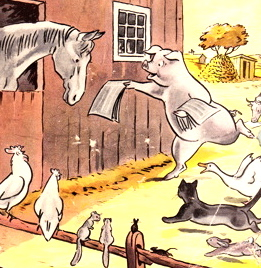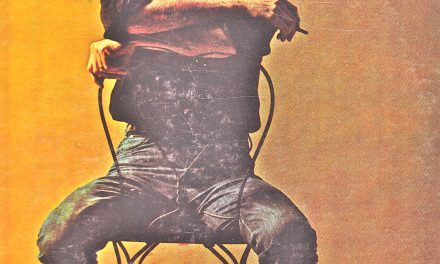Pigs could become a source of replacement organs for human beings in the not-too-distant future (assuming there is one). In September surgeons at New York University’s Langone Transplant Institute attached a pig’s kidney to a human patient and it functioned normally. The pig had been genetically modified to reduce the chance that its organ would be rejected, the patient was brain dead and sustained on a ventilator, the kidney was attached outside the body, and the results tracked for only 54 hours… but the feasibility of using pigs for human replacement parts was established.
The story was broken not in a medical journal but in USA Today. Roni Caryn Rabin relayed the news in the NY Times Oct. 19. “Experts in the field hailed the surgery as a milestone,” she wrote. “A steady supply of organs from pigs — which could eventually include hearts, lungs and livers — would offer a lifeline to the more than 100,000 Americans currently on transplant waiting lists, including the 90,240 who need a kidney. Twelve people on the waiting lists die each day.”
Kidney failure has made more than half a million US Americans dependent on dialysis. Few get transplants because available organs are scarce. Some are donated by loved ones, most are “harvested” from the newly dead.
“In a close approximation of an actual transplant procedure,” Rabin wrote, “the kidney was attached to blood vessels in the patient’s upper leg, outside the abdomen. The organ started functioning normally, making urine and the waste product creatinine ‘almost immediately,’ according to Dr. Robert Montgomery, who performed the procedure. ‘It just looked like any transplant I’ve ever done from a living donor. A lot of kidneys from deceased people don’t work right away, and take days or weeks to start. This worked immediately.'”
About 40,000 organ transplants were performed in the US last year, more than 23,000 involving kidneys. Specialists in the field are understandably enthused. Dr. Amy Friedman told Rabin that she “envisioned using hearts, livers and other organs grown in pigs, as well. ‘It’s truly mind-boggling to think of how many transplants we might be able to offer,’ she said, adding, ‘You’d have to breed the pigs, of course.’
“The prospect of raising pigs to harvest their organs for humans is bound to raise questions about animal welfare and exploitation,” Rabin noted, “though an estimated 100 million pigs already are killed in the United States each year for food.” She quoted the inevitable statement from People for the Ethical Treatment of Animals (PETA): “Pigs aren’t spare parts and should never be used as such just because humans are too self-centered to donate their bodies to patients desperate for organ transplants.”
I once wrote a song called Lucky, the Lab Mouse that PETA people objected to on YouTube. So I added a comment to mollify them: “This was meant as a joke. I know that lab mice NEVER have a nice day.”
Getting back to Rabin’s piece in the Times: “Pigs offered advantages over primates for organ procurement — they are easier to raise, reach maturation faster, and achieve adult human size in six months. Pig heart valves are routinely transplanted into humans, and some patients with diabetes have received pig pancreas cells. Pig skin has also been used as temporary grafts for burn patients…
“The kidney used in the new procedure was obtained by knocking out a pig gene that encodes a sugar molecule that elicits an aggressive human rejection response. The pig was genetically engineered by Revivicor and approved by the Food and Drug Administration for use as a source for human therapeutics.
“Dr. Montgomery and his team also transplanted the pig’s thymus, a gland that is involved in the immune system, in an effort to ward off immune reactions to the kidney.”
The Cannabis Angle
In 1988 Dr. Allyn Howlett and colleagues at the St. Louis University School of Medicine identified a receptor in the brain of a rat that was activated by the THC in Cannabis. This triggered an intense search for the compound(s) in the human body that would activate the newly named “cannabinoid receptor.”
“Receptors are made for compounds that we produce, not because there is a plant out there,” the great chemist Raphael Mechoulam explains to filmmaker Zach Klein in a first-rate biopic called The Scientist. To help search for the body’s own “endogenous” compound that would activate the receptor that responds to THC, Mechoulam recruited brilliant researchers —Lumír Hanuš, Aviva Breuer, and William Devane (who had been in Howlett’s lab when the receptor was identified).
“We initially worked on brains of pigs,” Mechoulam sayes of the search for the endogenous cannabinoid. “It is generally accepted that the organs of pigs and the organs of humans are somewhat closely related.And probably pigs and humans are also somehow closely related. Well, I’m not sure that the pigs will be very happy to be related to humans, but that’s something else.
“So we wanted to work on pig brains and pig brains are not so easy to get in Jerusalem.” A butcher was found in Tel Aviv who gave them the brains readily at first, but began charging as he realized that his new customers had an ongoing need for the material. Hanuš recalls, “Each time when we came to buy it again, the price was higher. At the end it was very expensive.” (You might say the butcher was jewing them up, but then you might get chappelled.)
Other scientists were seeking to identify the endogenous cannabinoid and the stakes were high. Devane recalls taking a thin slice of radioactively tagged brain material which he would place “over a silica sand column and separate a few fractions and test them for how they bound to the receptor. And I thought, ‘Oh, it won’t take long.’” But it took more than a year until they had isolated a small amount of compound they identified as arachidonoyl ethanolamide. “It was only like a few droplets in the end of a little test tube,” Devane remembers.
Devane, who had studied Eastern philosophy, proposed that the newly identified cannabinoid should be named for the Sanskrit word for bliss, ananda. “Although some people do not agree with me,” Mechoulam tells Klein in his biopic, “in Hebrew there are not too many names for happiness. For sorrow you can find a lot of names, but… not for extreme happiness.”
Because the compound was an ethanol amide, and amide fit nicely behind the Sanskrit root, the endogenous cannabinoid was dubbed “anandamide” —a name that says something about its effect and its chemical structure. The finding was published in a 1992 paper announcing the “Isolation and Structure of a Brain Contituent that Binds to the Cannabinoid Receptor.” Brilliant Bill Devane’s name comes first among the 10 authors, and Mechoulam’s last as befits the lab director.
My Role Model
A jockular journalist jotting down notes
A pink politician plying for votes
A daring detective digging for clues
Forever a folkie but singin’ the blues
Every year he like changes his gig
Oink oink oink says Freddy the Pig.
A friend to the ducks, the horse and the cat
Even respected by Simon the rat
He joined the circus then a football team
Helps Mrs. Wiggins deliver the cream
Pass me that jug, gimme a swig
Oink oink oink says Freddy the Pig
A Madison Avenue idea man
A Scientific American
An organizer grasping at straws
A pig, above all, whatever the cause
He traveled to Florida
Canada, Rome
Camped with Weedly
and peddled his poems
Angered authorities, muckraked the brig
Oink oink oink says Freddy the Pig
A chick chirped “Pig!” at him shaking her fist
Freddy said Why be a species-ist?
Mr. Bean knows I’d never harm
The chicks or anyone else on this farm
And there’s more to me than my loins you might dig
Oink oink oink says Freddy the Pig.
Peddled espresso in an Army town
Brought a big cult leader down
Broke the news about CBD
Saw the movement fall to The Industry
Then she said Fred the thing you do
Is hide your feelings —but how come she knew?
He concluded it’s really a case
Of everything showing too clear on his face
His hate is pure but his love is big
Oink oink oink says Freddy the Pig
Oink oink oink says Freddy the Pig.





